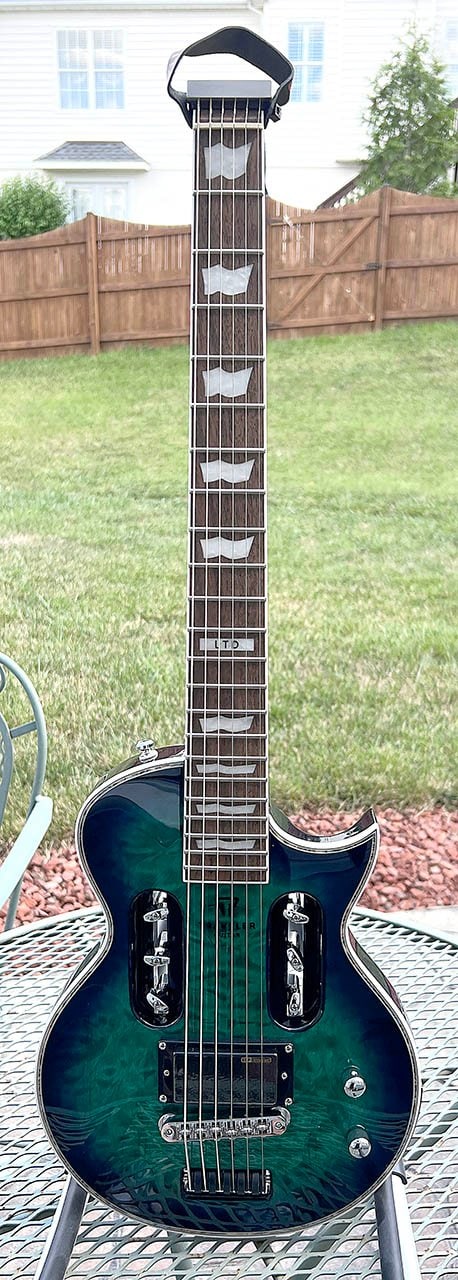Headless guitars and basses have become increasingly popular over the last few years. Due to their lightweight and compact design, they have become the preferred guitar of many touring musicians.
Another advantage is the fact that they stay in tune for longer due to the unique way their strings are set up.
Though, being headless also means that traditional tuning methods don’t exactly work on these types of guitars.
Table of Contents
How to Tune a Headless Guitar
Putting strings on and tuning a headless guitar isn’t too different from a regular guitar.
Simply loosen the tuning knobs at the back of the bridge, feed the ball end of the string through the saddle or adjuster tube, and connect the ball end to the tuner knob.
Feed the other end of the string through the nut on the neck, and tighten. Then just tune your guitar as normal using the tuning knobs on the bridge.
Because you don’t have a headstock, clip on guitar tuners are obviously out of the question. You can still use a tuner pedal like this, combo tuners, or tuning apps.
Difference Between Headless and Headstock
The obvious difference between a headless guitar and a traditional one is that the one has a headstock and the other, well, doesn’t.
Not having a headstock means that headless guitars aren’t stringed the same way and therefore, can’t really be tuned the same way.
Normally, the strings are attached to the bridge and then pulled up to the headstock. Here they are wound and held in place by string pegs.
These pegs are then connected to tuning machine heads that turn them. These then tighten or loosen the strings to tune them.
The strings pass through the guitar’s nut and over the fretboard to the saddles on the bridge. From here, they either go through the body, as with some Fender-style guitars, or to a tailpiece, more common Gibson-style guitars and acoustic guitars.
On a headless guitar, the strings are in reverse. They are anchored to a bridge at the end of the neck, where the headstock would have been, and then pulled over the fretboard to tuning heads on the body of the guitar.
Here the strings are fed through string adjuster tubes and connected to adjuster knobs.
The other key difference between headless and headstock guitars is the “zero fret.” When you play an open string on a traditional guitar, you’re playing the resonant length limited by the guitar’s nut at the end of the headstock.
This has a different tone and resonance than the identical note would when fretted. For example, fret the fifth fret of the E string on a headstock guitar. Then play the open A note. While the pitch of the notes is identical, the timbre and tone of the notes will be very different.
On a headless guitar, there is no nut. Instead, the guitar’s open strings have a “zero fret”. This gives the open strings on the guitar a sound more similar to that of a fretted note.
When I first started playing a headless guitar, this bugged me for a couple of days! I could tell something was off, but couldn’t pinpoint it. I also had to rule out the unorthodox appearance simply having a placebo effect on me!
Advantages of Headless Guitars

Reliable Tuning
The advantage of having the strings set up in this way is that they are effectively anchored at two positions, instead of just one on a traditional guitar.
This helps to keep the strings in tune for longer as they aren’t being moved back and forth in string pegs.
Having the tuning knobs at the back of the guitar also has the advantage of cutting down on the distance you have to cover to tune your strings.
This is helpful while you’re busy playing and need to make quick adjustments. You can also keep fretting a string while tuning it.
So, you don’t have to keep going from fretting to tuning, and, something I appreciate, your arm won’t start getting heavy if it’s taking a while to tune a string.
Better Balance
Headless guitars are also less prone to “neck dive”. Because there is less mass at the headstock end of the guitar, headless guitars are not as heavy away from the guitar’s body.
That way, when you play the guitar standing up, the headstock end of the neck doesn’t move toward the ground. “Neck dive” is more common with certain models of guitar than others, such as the Gibson Firebird and similar 1970s-era big-headstock guitars.
Great for Traveling
It’s no surprise that, considering the compact size of headless guitars, they’re a favorite for traveling musicians.
The smaller size and reduced weight of the headless guitar makes it a perfect travel companion. LTD introduced the diminutive EC-1, equipped with powerful humbucking pickups, as a travel guitar.

Travel-sized headless instruments aren’t just for electric players, either. Those who want to dispense with an amplifier will enjoy the light weight and acoustic resonance of the Traveler Guitar. This ultra-light instrument is designed for inclusion in your luggage, perfect for guitarists on the go.
In Conclusion
With their advantages in weight, size and how well they keep in tune, it’s easy to think that they might just be a gimmick.
But considering that they are also easy to play and set up, it’s no wonder that headless guitars have gained so much popularity over the last few years.


Hi what brand are the first two guitars on the left of the main picture?
It’s Harley Benton.